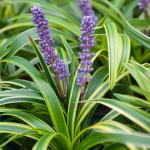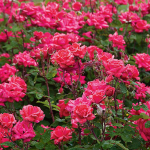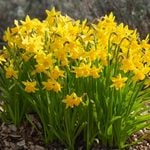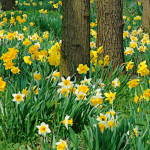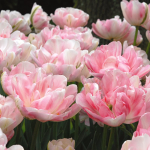Product Details
The Impression Tulips are robust Darwin Hybrid cousins, with tall, strong stems bearing large, luminous blooms. They include the much loved 'Pink Impression' and its sports. If you had a hard time choosing among them, you'll enjoy our mix of apricot, pink, and red varieties—a magical blend of related colors. As part of the Darwin clan, the Impressions are long-lived, and all bloom at the same time, midseason. 25 bulbs cover 5 sq ft. Not Labeled.
Tulipa is an enormous genus, consisting of approximately 75 species. Tulips are native to areas including the Middle East and the foothills of the Himalayan mountains. These regions have long cold winters and hot, bone-dry summers, and these are the conditions in which Tulips perennialize (or, in other words, return year after year) most successfully. In North America, it’s difficult, if not impossible, to replicate these climatic conditions, and as a result, we recommend that most Tulips are treated as annuals. Plant the bulbs in fall, enjoy their colorful blossoms in spring, and when the flowers subside, remove the plants, including the bulbs, and compost or discard them. The advantages to this ritual are three-fold: You won’t spend weeks of spring waiting for second- or third-year Tulips that don’t bloom; you won’t spend weeks eyeing yellowing and decaying Tulip foliage in your gardens; and you can look forward to the considerable delight of choosing new varieties, colors, and forms each season to refresh your display.
All that said, there are a few Tulips that are more likely to perennialize than others. Species Tulips, sometimes referred to as “botanical Tulips,” have smaller, somewhat wilder looking flowers than the hybridized goblet forms, but they are more forgiving of milder climates, and they are known to return for two to three years in a favorable site. Long-stemmed, goblet-shaped Darwin hybrids have been bred to offer multi-year performance, and Fosteriana Tulips generally return for up to three years (and sometimes more) under ideal conditions.
Tips for Good Tulip Culture
- In the fall, plant Tulip bulbs in a sunny site with very well-drained soil.
- Plant the bulbs at least 6" deep so they stay insulated through the winter but remain cool as temperatures begin to rise in spring. (Bulbs that are kept cool in spring tend to blossom for a longer period.)
- Treat most Tulips as annuals. Enjoy the flowers in spring, and when they subside, remove the entire plant, including the bulb, and compost or discard.
- Choose Tulip varieties for next spring, and plant them in fall.
For more information on the growing and care of Tulips, click Growing Guide.
Shipping
HOW PLANTS ARE SHIPPED
The size of the plants we ship has been selected to reduce the shock of transplanting. For some, this means a large, bareroot crown. Others cannot travel bareroot or transplant best if grown in containers. We ship these perennials and annuals in 1 pint pots, except as noted. We must point out that many perennials will not bloom the first year after planting, but will the following year, amply rewarding your patience. We ship bulbs as dormant, bare bulbs, sometimes with some wood shavings or moss. Shrubs, Roses, vines, and other woody plants may be shipped bareroot or in pots. The size of the pot is noted in the quick facts for each item.
WHEN WE SHIP
We ship our bulbs and plants at the right time for planting in your area, except as noted, with orders dispatched on a first-come, first-served basis by climate zone. We also ship a wide range of containers and planters, tools, supplies, fertilizers, garden wear, garden decor items, as well as indoor decorations like wreaths and dried bouquets when available. Estimated dates for shipping are indicated in the green Shipping Details box for each item. Please supply a street address for delivery. Kindly contact us with two weeks notice, if you'll be away at the expected time of delivery.
OUR GUARANTEE
We guarantee to ship plants that are in prime condition for growing. If your order is damaged or fails to meet your expectations, we will cheerfully replace or refund it. Please contact our Customer Service Department at 1-800-503-9624 or email us at [email protected]. Please include your order number or customer number when contacting us.
Reviews
Average Customer Rating:
 (8 Reviews)
Write a Review
(8 Reviews)
Write a Review
Sort by:
Amazingly beautiful 
A viewer from Huntsville AL
After they bloomed, I called White Flower farm to ask if they would rebloom. Customer service told me to pull them out and throw them away so I did. I wish that I had not done that because I missed pulling up some bulbs around the trees, and these come up every year.
My arborist told me not to plant new tulips under the trees because it would damage the roots. I bought 100 more this year, planted them along the house. They were amazingly beautiful too. I wish the tulips were still under the trees.
4 of 4 people found this review helpful. Do you? yes no Certified buyer
I will not give up 
reggie the tulip guy from Rancho Beligo ca
4 of 6 people found this review helpful. Do you? yes no Certified buyer
Best tulips ever! 
Kathleen the dirt gardener from Baltimore, Maryland
15 of 15 people found this review helpful. Do you? yes no Certified buyer
mixed review... 
Janie from Tolono, IL
Growing guide
These indispensable bulbs have been enjoyed in gardens around the world for centuries. Tulips today are available in many shapes, sizes, and seasons of bloom and the smart gardener can have Tulips blooming from early spring through May in a multitude of colors. For the best display, avoid the "soldier effect" and plant the bulbs in clusters. Plant large bulbs 5–6″ apart and smaller bulbs 2–3″ apart. Small Species Tulips are ideal for rock gardens and the tall, large-flowered varieties can hold their own anywhere.
Bulb size: 12 cm /species 5-10 cm
Light/Watering: Tulips perform best in full sun in the North and will tolerate very light shade in hotter areas. Unless the season is unnaturally dry, normal rainfall should suffice.
Fertilizer/Soil and pH: Tulip bulbs require a well-drained soil. Sandy soil enriched with organic matter is ideal as is a pH of 6.0 to 6.5. Keep Tulip bulbs cool (below 65°) until ready to plant. Plant in fall at least a month before the ground freezes. Follow directions for planting depth for individual varieties. Many Tulips (the midseason and late-flowering varieties in particular) tend to bloom magnificently the first spring or two after planting and decline thereafter. Species Tulips, Darwin Hybrids, Fosterianas, Greigiis, Kaufmannianas, and WFF Perennial Tulips can put on a stunning display for several years with your help:
- Plant at the depth recommended on the plant label (or slightly deeper); we recommend you plant large bulbs 8–10″ deep, smaller bulbs and species Tulips 5–6″ deep.
- Remove blooms (on all but the species Tulips) as soon as they fade to prevent the formation of seeds.
- Allow the leaves to yellow before removing them.
- Fertilize in fall and early spring with any of our fertilizers specifically formulated for bulbs.
- Tulips will also perform more reliably if they are not watered during their summer dormancy.
Most early and midseason Tulip varieties are excellent for forcing. Rooting time is from fourteen to sixteen weeks. More information on forcing bulbs may be found on our Web site.
In parts of the country where winters are mild, Tulips may not receive enough natural cold to stimulate proper growth and flowering. We recommend treating these as annuals and replacing them with new bulbs every year. Check with your local USDA Cooperative Extension Service to find out whether any bulbs require prechilling before planting in your area. Place the bulbs in a refrigerator, away from fruits and vegetables (these produce ethylene gas, which can harm the embryonic flowers inside the bulbs). Make sure the bulbs remain dry. The usual prechilling time is ten weeks or longer at 40 to 45°F. Once the bulbs are removed from cold treatment, plant them right away. Bloom occurs about six to eight weeks after planting. Discard the entire plant after bloom.
Please note: An amber gel-like substance called gummosis is sometimes present on Tulip bulbs. It is not harmful and will not affect the bulbs' performance.
Pests/Diseases: Aphids may be a problem, but are easily washed off with a water spray. If you notice spindly stems and white or yellowish mottling or streaking of the foliage suspect a virus and dig up and destroy the bulb.
Companions: Tulips are lovely with other spring bloomers and with each other. Mertensia virginica is a sweet companion and Tulips are perfect planted beneath ground covers like Epimedium or Vinca. Underplant Tulips with Forget-Me-Nots for a classic combination.
Pruning: Direct energy to the Tulip bulb by removing spent blooms and developing seed capsules.
End of Season Care: Wait until Tulip leaves have yellowed completely before cutting them back. Many gardeners consider Tulips to be one of the best bargains in the plant world and treat them as annuals. This method relieves the gardener from having to plant bulbs deeply, not being able to water garden areas where Tulips are planted, deadheading plants, and looking at unattractive foliage for the summer.
Calendar of Care
Early spring: Fertilize bulbs now with a suitable formulation.
Mid-Spring: Enjoy the show and cut flowers for gorgeous bouquets. Watch for aphids and wash off if present.
Summer: Deadhead Tulip plants to remove developing seed capsules. Do not water Tulip beds, as most varieties prefer to stay dry in summer, and keep beds weeded. Do not remove foliage until it has yellowed completely.
Fall: Plant new bulbs at least a month before the ground freezes and water in. Check pH and adjust to 6.0 to 6.5. Fertilize established plantings now.

